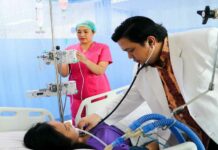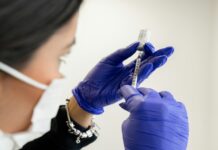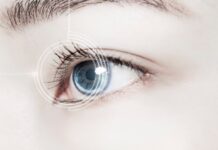Understanding PRP and Its Role in Hair Loss Treatment
PRP, or Platelet-Rich Plasma, is gaining attention for its application in treating hair loss. This section explores the scientific principles behind PRP and identifies the types of hair loss that can benefit from this innovative treatment.
The Science Behind PRP
PRP hair loss treatment involves drawing a small amount of a patient’s blood and processing it to concentrate the platelets. The platelets contain growth factors that play a crucial role in tissue regeneration and healing.
Once concentrated, the PRP is injected into the scalp where hair thinning occurs. The growth factors aim to stimulate hair follicles, promoting natural hair regrowth.
Research indicates that PRP can improve hair density and thickness by enhancing the blood supply to hair follicles. This can potentially slow down hair loss and encourage new hair growth in both men and women.
Types of Hair Loss Treated with PRP
PRP is primarily indicated for androgenetic alopecia, commonly known as male or female pattern baldness. This condition affects a significant percentage of the population.
Additionally, it can also benefit individuals with alopecia areata, an autoimmune disorder that leads to sudden hair loss.
Patients experiencing traction alopecia, often caused by hairstyles that strain hair, may find PRP helpful.
It is important for individuals to consult a qualified professional to determine the suitability of PRP for their specific hair loss type. Proper diagnosis will ensure optimal treatment outcomes.
The PRP Treatment Process
The PRP hair loss treatment process involves specific steps that ensure the procedure is effective and safe. Key components include preparation, the procedure itself, and aftercare.
Preparation and Procedure
Before the procedure, a consultation takes place to assess the patient’s health and hair loss condition. This may involve blood tests to rule out underlying issues.
On the day of treatment, the medical professional draws a small amount of blood, typically from the arm. The blood is then placed in a centrifuge, which spins it at high speeds to separate the platelet-rich plasma from other blood components.
The concentrated PRP is collected and injected into areas of the scalp where thinning occurs. Multiple injections are usually administered to stimulate hair follicles effectively. The entire procedure takes about 60-90 minutes.
Afterwards, patients can typically resume normal activities immediately, although some may experience minor discomfort or swelling.
Aftercare and Follow-up
Post-treatment care is crucial for optimal results. Patients are advised to avoid intense physical activity for at least 24 hours to minimize any potential discomfort and swelling.
It is also recommended to avoid hair products such as gels or sprays for a few days. Regular follow-ups help track progress and assess the need for additional treatments, typically scheduled every 4-6 weeks.
Patients may notice initial changes within a few months, with fuller hair appearing over the following months. Continuous communication with the healthcare provider ensures any concerns are addressed promptly.
Efficacy of PRP Treatments
PRP hair loss treatments often lead to varying outcomes based on clinical studies and patient experiences. Evaluating both scientific research and individual satisfaction provides a clearer picture of their effectiveness.
Clinical Study Outcomes
Numerous clinical studies have explored the efficacy of PRP treatments for hair loss. A significant amount of research has indicated positive results in promoting hair growth. For instance, a study published in the “Journal of Cutaneous and Aesthetic Surgery” noted that over 70% of participants experienced noticeable hair regrowth after a series of PRP sessions.
Results typically show an increase in hair density and thickness. Data show that PRP treatments can lead to a 30-40% improvement in hair count within a few months. Factors influencing outcomes include the severity of hair loss, the number of sessions, and the individual’s overall health.
Patient Satisfaction and Results
Patient satisfaction data reveal generally favorable responses to PRP treatments. Many patients report an increase in confidence and improved self-image after undergoing therapy. Surveys indicate that around 80% of individuals felt satisfied with their results after six months.
Results can vary widely among different demographics. Factors such as age, gender, and the extent of hair loss contribute to these variations. Most patients note a gradual improvement, often requiring patience as hair regrowth takes time. Regular follow-ups are crucial to assess ongoing effectiveness and to manage expectations effectively.
Potential Risks and Side Effects
PRP hair loss treatments come with a range of potential risks and side effects. Understanding these aspects is important for anyone considering this procedure.
Common Side Effects
The most frequently reported side effects of PRP treatment include pain at the injection site, swelling, and redness. Patients may also experience itching or a mild headache, which generally resolves within a few hours to a couple of days.
In rare cases, individuals might encounter infection or scarring related to the injection process. Although uncommon, some patients may also develop allergic reactions to the materials used during the treatment. This underscores the importance of consulting with a qualified practitioner before proceeding.
Risk Mitigation Strategies
To minimize risks, selecting a certified and experienced provider is crucial. They should follow strict safety protocols and maintain a sterile environment during the procedure.
Patients should also disclose their full medical history, including any medications they are taking. This information can help identify potential interactions or contraindications.
Post-treatment care is essential. Following aftercare instructions, such as avoiding strenuous activity and keeping the scalp clean, can further reduce the likelihood of complications. Regular follow-ups can help monitor progress and address any emerging issues promptly.
Comparing PRP to Alternative Therapies
PRP therapy offers a unique approach to hair restoration, but several alternative treatments exist. Each option has distinct methodologies and results, which are important for individuals considering their choices in addressing hair loss.
Medications
Medications such as minoxidil and finasteride are widely used for treating hair loss. Minoxidil is a topical solution that stimulates hair follicles, promoting growth in both men and women. It is available over the counter and can be applied directly to the scalp.
Finasteride, on the other hand, is an oral prescription medication primarily for men. It works by inhibiting the hormone dihydrotestosterone (DHT), which contributes to hair loss. Side effects are possible, making consultation with a healthcare provider essential.
Both medications require consistent use and may take several months to show results. Efficacy varies among individuals, and some may experience regrowth while others may see limited improvement. Long-term commitment is crucial for sustained benefits.
Hair Transplant Surgery
Hair transplant surgery is a more invasive method for restoring hair. It involves relocating hair follicles from a donor area, often the back of the head, to thinning or bald regions. Two main techniques are used: Follicular Unit Transplantation (FUT) and Follicular Unit Extraction (FUE).
FUT involves removing a strip of scalp, while FUE extracts individual follicles. Both techniques have their merits, including natural-looking results and permanent hair growth. Recovery times vary, and patients may experience discomfort post-procedure.
This option is generally more expensive than PRP therapy and medications. Results can be seen in several months, as hair follicles enter a growth cycle. Individuals considering this option should evaluate the cost, potential complications, and time commitment involved.
Low-Level Laser Therapy
Low-Level Laser Therapy (LLLT) utilizes light to stimulate hair growth. Devices, such as caps or combs equipped with lasers, are designed for use at home or in clinics. The theory is that laser light enhances cellular activity in hair follicles, promoting growth.
Sessions typically last 20 to 30 minutes and are recommended several times a week. Research indicates LLLT may be effective for some, particularly those in early stages of hair loss. Patient experiences vary, with some reporting noticeable improvement in hair density.
LLLT is non-invasive and poses minimal side effects, although its efficacy can differ between individuals. It may be used alone or in conjunction with other treatments for enhanced results.
















